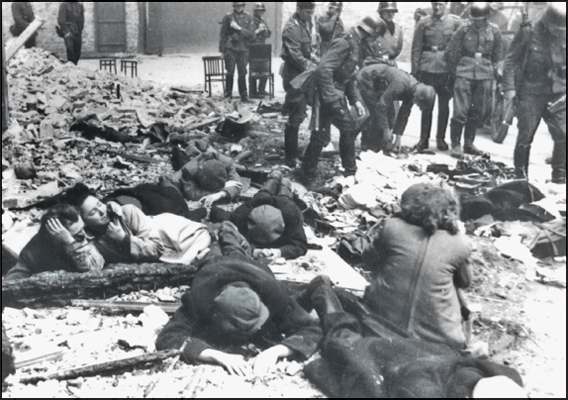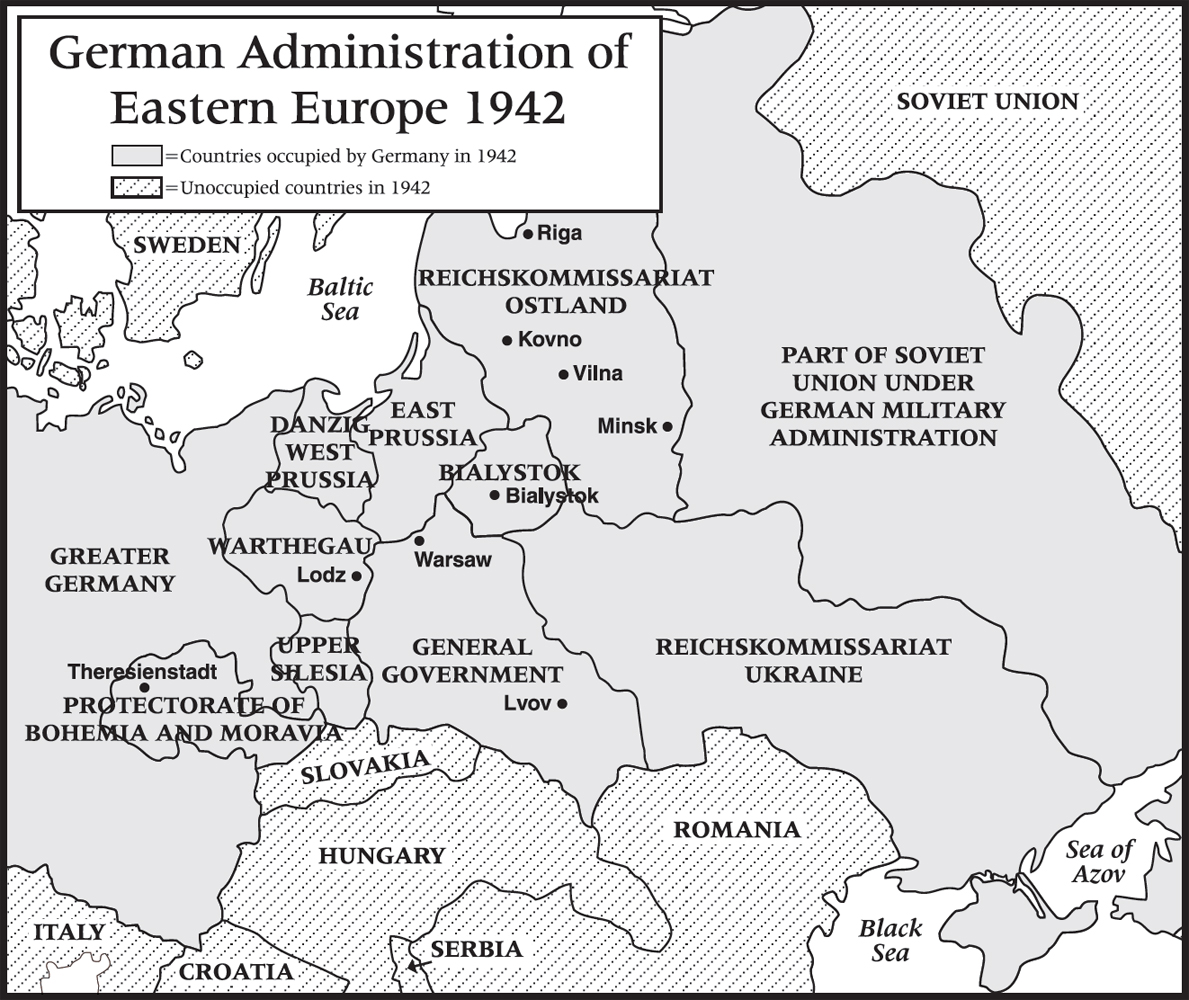
Many Jewish resistance fighters were killed by SS guards during the Warsaw uprising. Here, a group of resistance fighters surrenders to a Nazi patrol.

Many Jewish resistance fighters were killed by SS guards during the Warsaw uprising. Here, a group of resistance fighters surrenders to a Nazi patrol.
When World War II ended in 1945, a nameless horror became apparent: the deliberate murder of approximately 6 million European Jews and 5 million Gypsies, Poles, Slavs, and others by the forces of Nazi Germany. This war-within-a-war came to be known as the Holocaust, from the word meaning “wholesale destruction and loss of life, especially by fire.”1
The period of Nazi domination began on January 30, 1933, when a rabble-rouser named Adolf Hitler became chancellor of Germany, second in command to President Paul von Hindenburg. Hitler was a vicious anti-Semite who believed that the Nordic peoples, or “Aryans” as he called them, were a master race, destined to rule the world. The Jews were destined only to die, and the rest of the world’s “inferior” peoples to serve as slave labor for the Aryan masters.
He promised the German people a glorious Third Reich (government or “empire”): the Holy Roman Empire was the first Reich; the unified German Empire of Prince Otto von Bismarck, the second. Now would come Nazi Germany, with Adolf Hitler as its führer, its absolute leader. This grandiose plan ended on the battlefields of World War II, and in the gas chambers of the concentration camps.
Hitler did not invent anti-Semitism, nor did he force it on an unwilling public. For centuries, European Jews were persecuted by the Christian majority. In 1096, Crusaders on their way to kill Muslim nonbelievers in Palestine slaughtered thousands of Rhineland Jews as “Christ killers.” The charge was more than a thousand years old, based upon the belief that Jewish leaders had plotted the death of Jesus. When a deadly epidemic of bubonic plague swept through Europe in the fourteenth century, the terrified populace killed Jews, claiming they had poisoned the wells.
Martin Luther, leader of the Protestant Reformation in the sixteenth century, decried the very existence of the Jews. He hated them because they refused to accept Jesus as the messiah (savior) of all humankind:
What shall we Christians do now with this depraved and damned people of the Jews? . . . I will give my faithful advice: First, that one should set fire to their synagogues. . . . Then that one should also break down and destroy their houses. . . . That one should drive them out of the country.2
Adolf Hitler harnessed this hatred and placed it at the center of his Nazi ideology. Jewishness, said the führer, was not simply a religious or cultural identity; it was “in the blood,” a matter of race. A Jew could not cease being Jewish by converting to Christianity and assimilating or blending into German culture. Hitler made no secret of his intentions toward members of this “poisonous” race; they must be eliminated if Germany was to achieve “greatness.”

Once he became chancellor, Hitler wasted no time in seeking this goal. On April 1, 1933, he mounted a symbolic one-day boycott of Jewish businesses all over Germany, and in May, he presided at a mass rally against Jewish intellectuals. Amid the pomp and splendor of martial music and torchlight parades, screaming Nazis burned books by Jewish authors and others who opposed the regime.
President von Hindenburg died on August 2, 1934. A new law that had been passed just a day earlier combined the offices of chancellor and president. Under that law, Hitler took power. He promptly did away with the title of president, to become known as führer, absolute dictator of the German nation. When that happened, the fate of the Jewish people and the German nation was sealed.
On September 15, 1935, the Nuremberg Laws were approved by the Nazi-controlled national assembly. These laws deprived Jews of German citizenship and excluded them from most areas of the German economy. Many fled the country at that time, some to safety in America and others to surrounding countries. There they would once again face destruction when the Nazi forces overran Europe.
The Jews have always been a resilient people, able to affirm life in the face of persecution and death. When things were bad, Jews thanked God that they weren’t worse. When things got worse, they comforted one another with the thought that “this too shall pass.” For countless generations, that ability to adjust and to endure has been one of their strengths.
The Nazis used this strength against them. To keep the Jews from open revolt, the Nazis hid their true intentions as long as possible. The ghettos (areas of cities where Jews were forced to live) played an important role in that strategy. In these grim areas, Jews could be isolated and controlled while the Nazis set the stage for genocide (the systematic killing of an entire racial, ethnic, political, or religious group).
The ghettos would exist for less than four years. The order that created them was issued on September 21, 1939; the order that liquidated them was issued on July 21, 1943. During that period, at various times, small ghettos were created and quickly eliminated, their populations either killed outright or sent to one of the larger ghettos. The United States Holocaust Memorial Museum recognizes nine major ghettos:3
In these hellish places, simply going about the ordinary business of life was an act of courage and defiance. Thousands starved to death or died of disease; some killed themselves; and some were shot down in the streets. Some fought back, although they knew the battle was hopeless.
Ultimately, the story of the ghettos, like that of the Holocaust itself, stands as a memorial to the victims and a warning to the rest of us that such things must never again be allowed to happen.